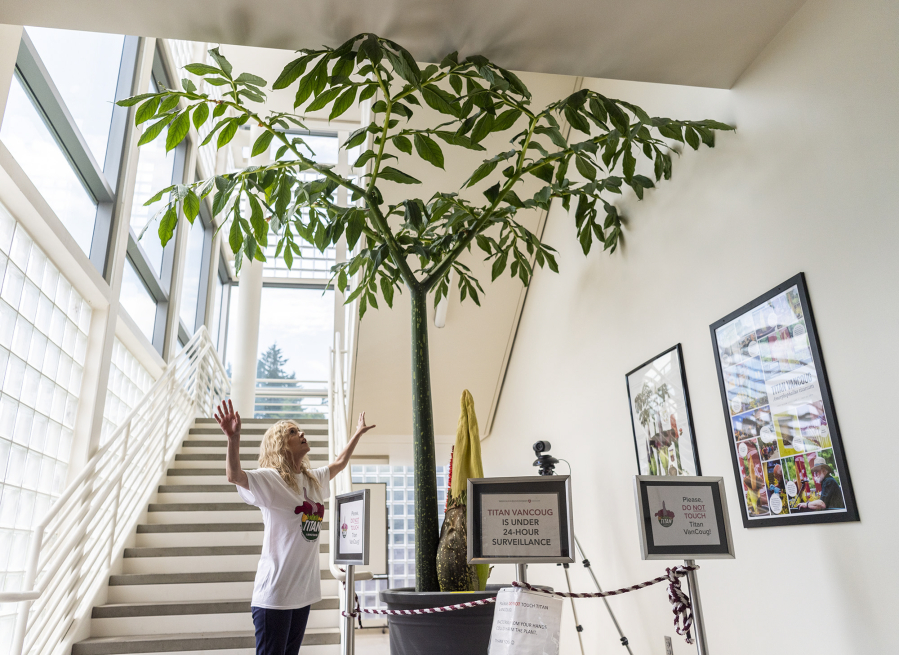Sound the alarms! It’s almost time for Vancouver’s favorite new holiday: a corpse flower bloom.
Yes, believe it or not, professors at Washington State University Vancouver who parent the school’s own exotic Sumatran plant believe it will bloom yet again in the next week or so. Though it’ll be the third time the plant has bloomed in four years, this year’s sighting can’t be missed.
Why so special this time? Well, now there’s four of them.
An overwatering accident years ago accidentally cloned the plant, creating four “corms” — essentially a central energy storage organ for plants — all in the same pot together. Because of that, almost like planets aligning, all four stages of the rare plant’s life cycle are on display at once.
The team of instructors taking care of the plant believe it’s unlike anything ever observed before.
“I’ve never seen any other garden or university with all three stages in the pot before,” said Dawn Freeman, a classroom support technician who’s been Titan VanCoug’s primary babysitter. “There’s not a lot of these things anyways, so this is really spectacularly unique.”
What am I looking at here?
There’s not a lot of elbow room in the pot.
On one side is the “leaf” — a treelike sprout shooting up over 10 feet high, essentially the size of a cherry or any medium-sized tree. But, again, it’s technically just a single leaf, perhaps the largest in the world.
Next to it is the soon-to-bloom bud we recognize as the corpse flower itself, reminiscent of a handless arm reaching up from the earth. When it blooms, the flower — among the largest in the world — will emit a horribly rotten stench much like a mountain of weeks-old garbage.
“There were so many flies in that flower it sounded like a beehive, it was unnerving,” said Mark Owens, a classroom support technician who admitted to nearly vomiting live on camera while tending to the bloom last year.
Behind the bud is the still-kicking leftovers of last year’s bloom: the plant’s matured structure. Almost like a Christmas tree made of chili peppers, the mature part is coated with little red fruits that can be harvested and sent to other universities or gardens to birth a whole new corpse flower.
And, yes, there’s even a fourth roommate in the pot: a “little nubbin” waiting to sprout just beneath the dirt. Not yet visible like its gigantic friends, the nubbin will likely sprout into another leaf.
Each week, Freeman and others pour about six gallons of water into the pot. Despite its rarity, size and overall strangeness in nature, especially with four different stages coexisting together, caretakers say it’s not overly temperamental.
“We think the pot needs more dirt,” Freeman said. “But it’s pretty self-sufficient, it seems to want to keep going no matter what we do.”
What to expect
As of Monday morning, Titan VanCoug’s active bud stood at 50 inches tall and has grown about an inch or so each day for the last week. Freeman said they can tell when a bud is about to fully bloom once it hits a growth spurt of about four to five inches of growth per day.
Despite its current size — already nearly the same height of the plant’s first bloom in 2019 — Freeman said they haven’t observed such a spurt yet and aren’t certain it’ll happen. For reference: last year’s bloom saw a maximum height of 69 inches but didn’t last the typical 24 to 48 hours due to high August heat.
Because of the delicate coexistence in the pot and the sheer height of the leaf, the plant won’t be able to be displayed outside like it has in recent years.
“It’s physically impossible to get it outside without risking destroying the whole plant,” Freeman said.
The school plans to have visitors line up outside the Science and Engineering Building by the greenhouse and have people come inside in groups to see the plant, housed in the building’s stairwell — the only space tall enough to hold it.
Aside from viewing logistics, a major challenge of this year’s bloom will be mitigating the plant’s stench indoors as much as possible. Freeman and her team plan on doing whatever possible to spare the rest of the building’s inhabitants from the corpse smell: shutting down air conditioning in the stairwell’s area, closing fire protection doors and more. Doors to outside will be kept open to help ventilation and allow flies to come in and pollinate the plant.
Freeman expects it’s more likely that the plant will bloom next week; the school is prepared to showcase the plant any day other than Tuesday, July 4, when the campus will be closed for the holiday.
“We’re keeping our fingers crossed it doesn’t happen Tuesday,” Freeman said, bowing to the enormous plant in respect.
The bloom will likely be able to be visited for a day or two. WSU Vancouver also has an active livestream of the plant on its website at https://www.vancouver.wsu.edu/.




